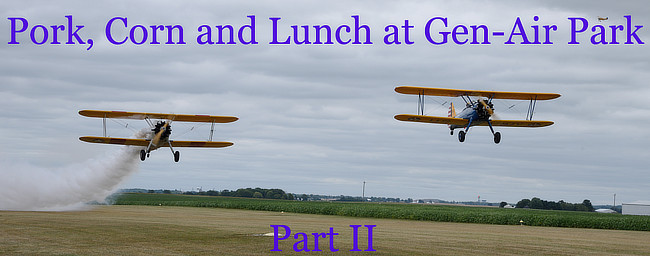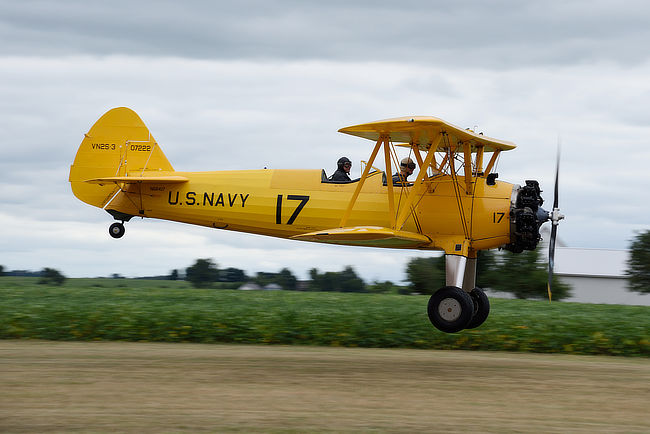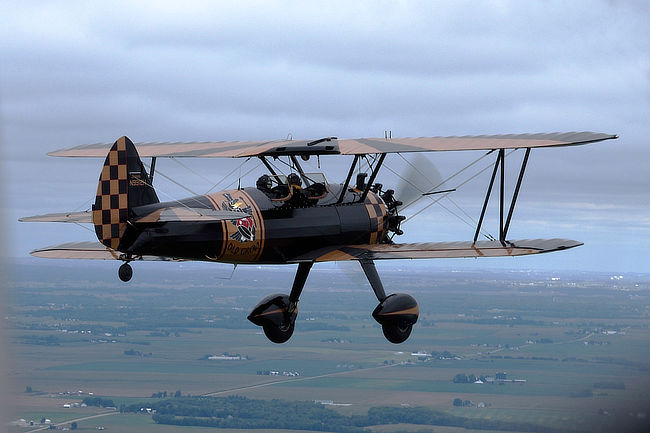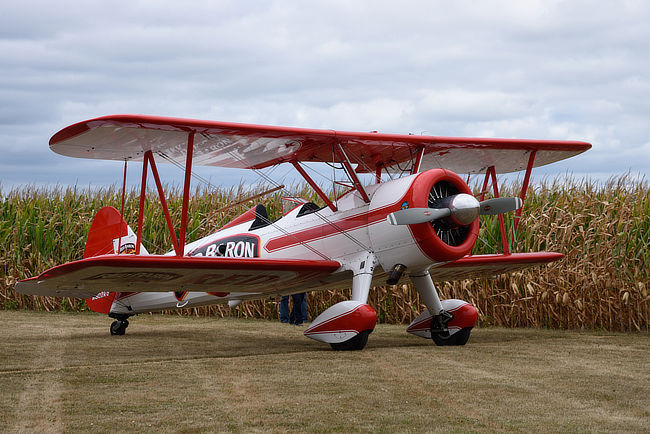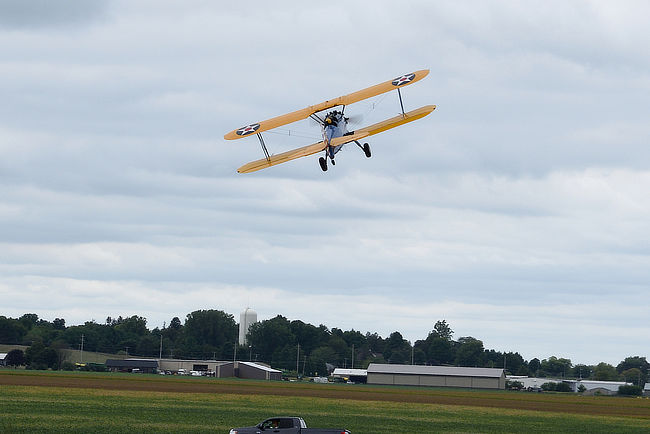ISSUE 851 - February 13, 2024 • Over 7,000 Total Ads Listed • 1,000+ NEW Ads Per Week
This eFlyer Has Been Sent To Over 152,000 Subscribers
|
| Pork, Corn and lunch at Gen-Air Park - Part 2 |
| Kevin Moore, Contributing Writer & Photographer |
|
Last week we had a look at the Gen-Air Park fly-in organised for the National Stearman Fly-in for their annual fly-out luncheon at the Geneseo, Illinois airstrip, located roughly 2 miles southeast of the town of Geneseo. This week we return to Gen-Air Park for another look at the event as well as some more history of the Boeing Stearman.
|
|
|
| The National Stearman Fly-in Stearman pilots that attended the Gen-Air Park fly-out lunch had a great day, despite some overcast skies. |
|
|
|
| Stearmans and their pilots always enjoy these fly-out luncheons, whether a bright sunny day or a bit of a dull, overcast day such as was had at the 2023 event. |
|
While Stearmans came and went through the late morning and early afternoon, many enjoyed the delicious meal served up by volunteers. For $10 you got a hearty meal of a pork cutlet, with or without a bun, corn on the cob, assorted salads, assorted dessert items and cold, non-alcoholic beverages and/or coffee. The volunteers are a wonderful bunch of folks who served up smiles and laughter while serving up your food. Occasionally, chatter in the hangar was broken up by the roar of a Stearman taking off or performing a low and over.
|
|
|
|
| Whether in US Navy yellow, left, or US Army blue, right, these historic aircraft represent a proud American aviation history. |
|
As mentioned in part I of the article, many US Army Air Corps and US Navy pilots were trained on the Boeing Stearman, also known as the Kaydet, across the United States at 41 assorted bases as well as in Europe and Canada. It's estimated that, from 1941 to 1944, as much as 50% of all American pilots were trained on the Stearman with an additional 10,000 RAF and Commonwealth pilots as British Flying Training (BFTS) bases in the US and British Commonwealth Air Training Plan (BCATP) bases in Canada as well as bases in the UK.
|
|
|
|
| There were other US Navy liveries, left, as well as other US Army liveries, right. |
|
Training pilots to fly is no easy task and thousands were killed during flight training. The average pilot's training lasted from 18 months to two years with pilots totaling 200 - 320 hours depending on ones aptitude. Throughout the wartime years, training was changed and adapted in order to provide much needed pilots and flight crews. The Stearman was an integral part of the pilot training and, though many were killed while learning to fly, the rugged Stearman could take some punishment at the hands of ham-fisted trainees.
|
|
|
|
| Even in civilian livery, the Stearman is a thing of beauty. Whether you fly in a lovely red & white or blue and white Stearman or one in military colours, you'll turn heads. |
|
Throughout the day at Gen-Air Park folks would watch Stearmans come and go. A few lucky locals were given the opportunity of a flight in the Stearman by a willing pilot. The Stearman has a look and sound unlike most any other former World War II training aircraft. Yes, there were other training aircraft but the Stearman was probably the largest biplane training aircraft available to Allied air forces during the war. For some Stearman owners it's important to honour the memory of wartime trainees, pilots and aircrew members who learned on the Stearman by having their aircraft painted to represent a specific wartime squadron or pilot. Military configurations were blue & yellow, yellow and grey, all grey and sometimes other liviers. The military versions are apparent by the US Army or US Navy markings and insignia to go along with the paint schemes.
|
|
|
|
Unfortunately, old aircraft do breakdown and the owner of this Stearman, left, had his pushed to a hangar for some required maintenance before he could return to flight.
A Stearman heading back to Galesburg, right. |
|
Though most Stearman owners ensure their aircraft are well maintained one has to remember that these aircraft are 80 years old, or older so parts break or fail at times. The Stearman first flew in 1934 in Wichita, Kansasa. It has a welded steel tube constructed fuselage covered in fabric with the exception of a few panels, mostly around the engine and front of the cockpit as well as the vertical and horizontal stabilizers. The wings are of wood construction and are fabric covered. The US Army Air Corps accepted its first training Stearmans, known as the PT-13, in mid 1936. By 1940 demand for the Stearman as trainers exceeded Lycoming's ability to provide the R-680 engine and Continental began production of their version of the radial engine, the R-670. These Stearmans were delivered as the PT-17. The RAF versions were referred to as the PT-27.
|
|
|
|
| Smoke on for a thank you to those who volunteered and attended the luncheon. |
|
Occasionally, one of the Stearman pilots would honour the volunteers and visitors with a smoky, low and over pass. Though not all Stearmans are outfitted with s smoke oil system, those who have them love to leave a smoke trail in the sky or over a runway. It may not be environmentally friendly but they don't do it all that often and most people, from pilots to spectators, love it.
|
|
|
|
| Two more lovely Stearmans in civie colours. |
|
Post-war, there were thousands of surplus, no longer needed aircraft, including the Stearman. Many were purchased from the US government to be used as private training aircraft, for barnstorming, carrying mail, banner towing and/or in agriculture for air spraying of farmer's crops. They were rugged, versatile workhorses and were flown hard and long. When some realised that these were also historic aircraft that deserved better, museums, historians and those wanting to honour the wartime memory of the aircraft started scooping them up, wanting them to be shown the same respect as aircraft such as the Mustang, Spitfire, Flying Fortress, Lancaster and other historic aircraft.
|
|
|
|
| There are many more Stearmans currently being restored to flying condition along with many as static museum pieces. Look for one at a museum or airfield near you. |
|
The Stearmans history dates back 90+ years, to its beginnings in Wichita, Kansas with the Stearman Aircraft Corporation. From those early days as Stearman, then Boeing, the Stearman has become synonymous with the history of the US Army Air Corps and the US Navy. When you visit the National Stearman Fly-in you find yourself enamoured with the aircraft and its history. The Gen-Air Park NSFI fly-out luncheon helps spread the history of these historic aircraft to young and old. It's important that this aircraft's history is passed along to younger generations so, even if you don't live near Gen-Air Park or Galesburg, find an aviation museum or group near you and maybe you'll find a Stearman or two in the collection. You might find a Stearman owner/pilot at your local airport as well, tucked away in a hangar on the airfield. If you do, go talk to the pilot or owner and talk to them about the aircraft and its history. You'll find yourself falling in love with the Stearman and then you can pass on your knowledge and love for the aircraft to your children, your grandchildren, nieces, nephews, friends and family. If you look deep, deep into your family history, you just might find that someone in your family tree learned to fly in the Boeing Stearman!
|
|
|
|
| Though the fly-out at Gen-Air Park was Stearman focused, there were a few civilian aircraft such as this beautiful Waco, left, and a sleek Cessna, right. |
|
|
|
| Heading back to Galesburg after lunch. |
|
|
|
| Two more Stearmans return to the air, heading back to the home of the National Stearman Fly-in at Galesburg, Illinois. |
|
|
Hans Nordsiek's "Old Crow" Stearman in formation with us in Bruce Bond's Canadian red & white Stearman, C-GSDK, ahead and off our left wing as we make our way to
Gen-Air Park for lunch. |
|
|
| One of the famous Red Baron Pizza, 450hp Stearmans. |
|
|
| Climbing away after a pass, bound for Galesburg after a delicious lunch at Gen-Air Park, Geneseo, Illinois. |
| By Kevin Moore, Contributing Writer & Photographer
|
|
| |
|


